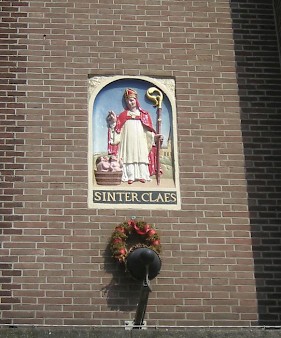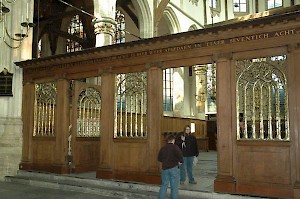Protestantism
Nicholas of Myra: early Christian bishop, who was in the Middle Ages venerated as patron of sailors and protector of blessed marriages (Saint Nicholas). As Sinterklaas, he remains a characteristic figure in Dutch folklore. He is also the historical figure behind Santa Claus.

't Misbruyck in Godes Kerck allengskens ingebracht,
Is hier afgedaen in 't jaer seventich acht.The abuse slowly introduced in the Church of God
was here abolished in the year seventy-eight.
This little rhyme can be read in the Old Church of Amsterdam, dedicated to Saint Nicholas. It is one of the few memories of the Reformation of the Dutch capital. During the Wars of Religion, the city had always kept a pro-Catholic course, but now it became Calvinist. Priests were forced to leave Amsterdam, the Inquisition was abolished, and Protestant exiles returned.
This was more than just a religious change. The returning exiles had established large international networks and as Protestants, they were supposed to honor God by industrious work. The old impediments to making profit -which according to Catholic doctrine needed justification- disappeared and an early form of capitalism, based on trade, was born. However, the old medieval mentality that profit was wrong as long as other people did not benefit as well, did not disappear, and many Dutch found their wealth embarrassing. Early capitalism retained some aspects of Catholic thought. This explains why Saint Nicholas remained popular in the world's first Capitalist nation.

We might expect the cult to have been abolished during the days of the Reformation, which held a dim view of the cult of saints. And indeed, several Protestant hard-liners have attempted this. As late as 1663, mayor Nicolaes Tulp (who was to become famous from Rembrandt's painting of the Anatomical Lesson) tried to prevent the celebration of his namesake's feast day, 6 December. He was merely led to look for another job: the Amsterdammers were fond of their saint.
They continued to sell special cookies and sweeties in December, continued to surprise their children with little presents hidden in their shoes, and continued to organize "official" visits, during which an actor, dressed like a bishop, preached to the children how to behave. If the enterprising spirit of the Amsterdammers found the sailor's patron appealing, the good bishop kept watch over their morals. Saint Nicholas, or Sinterklaas, as he was called, embodied the full range of their concerns. As Protestants, they no longer venerated him as a real saint, but the folkloristic exhange of presents remained popular.
A painting by Jan Steen, made in c.1665, shows how Sinterklaas was celebrated. In the center, we see the father of the family. His daughter has received a doll, and his youngest son points at the eldest son, who has obviously received nothing because he has not been a good boy. Fortunately, the maid points at grandma, who has found a present behind the curtain. To the right, a servant points at the flue, through which Sinterklaas has thrown the presents. We also see the mother, who has probably been in the kitchen to prepare all the sweet cookies we see on the floor.
The feast, which is still celebrated, is what anthropologists call an "archaic survival". Capitalism developed, profit no longer embarrassed people, modern society was being born; yet Sinterklaas kept some traits of an earlier period in which wealth was more connected with morality.